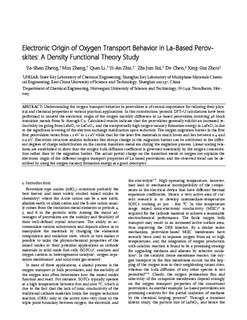| dc.contributor.author | Zheng, Ya-Shan | |
| dc.contributor.author | Zhang, Min | |
| dc.contributor.author | Li, Qian | |
| dc.contributor.author | Zhu, Yi-An | |
| dc.contributor.author | Sui, Zhi-Jun | |
| dc.contributor.author | Chen, De | |
| dc.contributor.author | Zhou, Xing-Gui | |
| dc.date.accessioned | 2020-02-05T11:09:32Z | |
| dc.date.available | 2020-02-05T11:09:32Z | |
| dc.date.created | 2019-05-02T12:27:56Z | |
| dc.date.issued | 2019 | |
| dc.identifier.citation | Journal of Physical Chemistry C. 2019, 123 (1), 275-290. | nb_NO |
| dc.identifier.issn | 1932-7447 | |
| dc.identifier.uri | http://hdl.handle.net/11250/2639777 | |
| dc.description.abstract | Understanding the oxygen transport behavior in perovskites is of central importance for tailoring their physical and chemical properties to various practical applications. In this contribution, periodic DFT+U calculations have been performed to unravel the electronic origin of the oxygen mobility difference in La-based perovskites involving 3d-block transition metals from Sc through Cu. Calculated results indicate that the perovskites generally exhibit an increased reducibility on going from LaScO3 to LaCuO3, and the exceptionally high oxygen vacancy formation energy in LaFeO3 is due to the significant lowering of the electron exchange stabilization upon reduction. The oxygen migration barrier in the first four perovskites varies from 1.2 to 2.1 eV while that for the later five materials is much lower and lies between 0.4 and 0.9 eV. Electronic structure analysis indicates this abrupt change in the migration barrier can be attributed to the different degrees of charge redistribution on the central transition-metal ion during the migration process. Linear scaling relations are established to show that the oxygen bulk diffusion coefficient is governed essentially by the oxygen concentration rather than by the migration barrier. The actual partial charge on the transition metal or oxygen ion explains the electronic origin of the different oxygen transport properties of La-based perovskites, and the observed trend can be described by using the oxygen vacancy formation energy as a good descriptor. | nb_NO |
| dc.language.iso | eng | nb_NO |
| dc.publisher | American Chemical Society | nb_NO |
| dc.title | Electronic Origin of Oxygen Transport Behavior in La-Based Perovskites: A Density Functional Theory Study | nb_NO |
| dc.type | Journal article | nb_NO |
| dc.type | Peer reviewed | nb_NO |
| dc.description.version | acceptedVersion | nb_NO |
| dc.source.pagenumber | 275-290 | nb_NO |
| dc.source.volume | 123 | nb_NO |
| dc.source.journal | Journal of Physical Chemistry C | nb_NO |
| dc.source.issue | 1 | nb_NO |
| dc.identifier.doi | 10.1021/acs.jpcc.8b11249 | |
| dc.identifier.cristin | 1695128 | |
| dc.description.localcode | This document is the Accepted Manuscript version of a Published Work that appeared in final form in [Journal of Physical Chemistry C], copyright © American Chemical Society after peer review and technical editing by the publisher. To access the final edited and published work see https://doi.org/10.1021/acs.jpcc.8b11249 | nb_NO |
| cristin.unitcode | 194,66,30,0 | |
| cristin.unitname | Institutt for kjemisk prosessteknologi | |
| cristin.ispublished | true | |
| cristin.fulltext | postprint | |
| cristin.qualitycode | 1 | |
